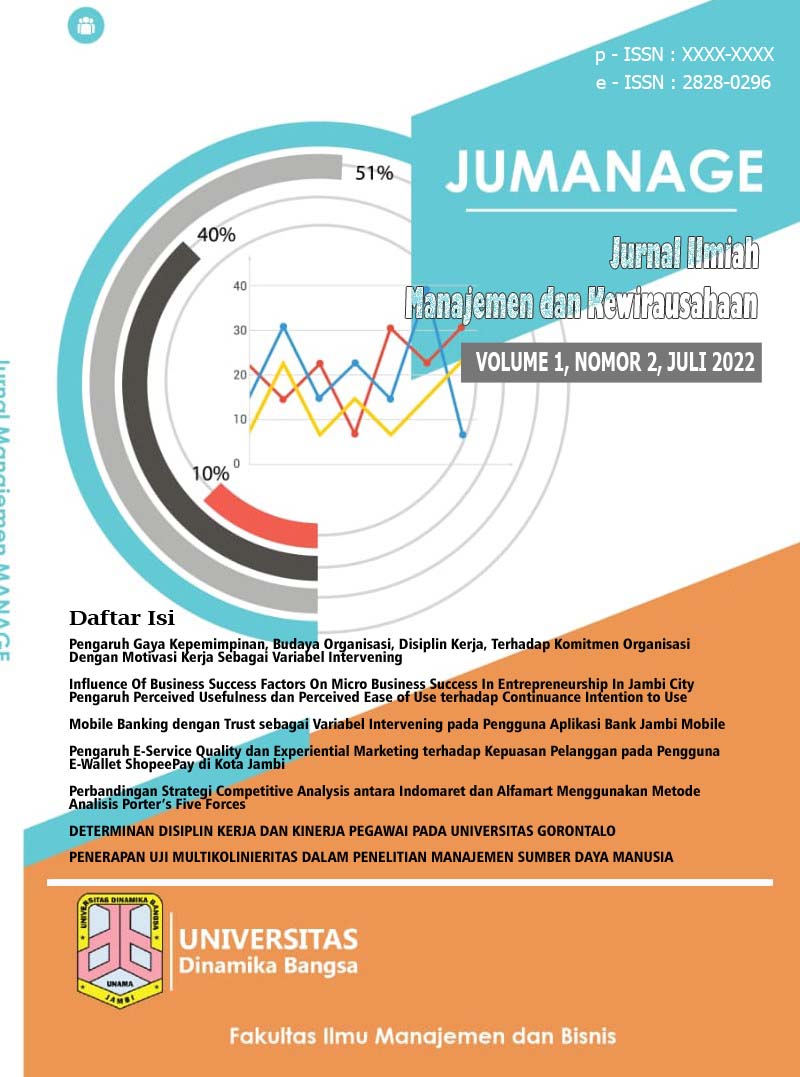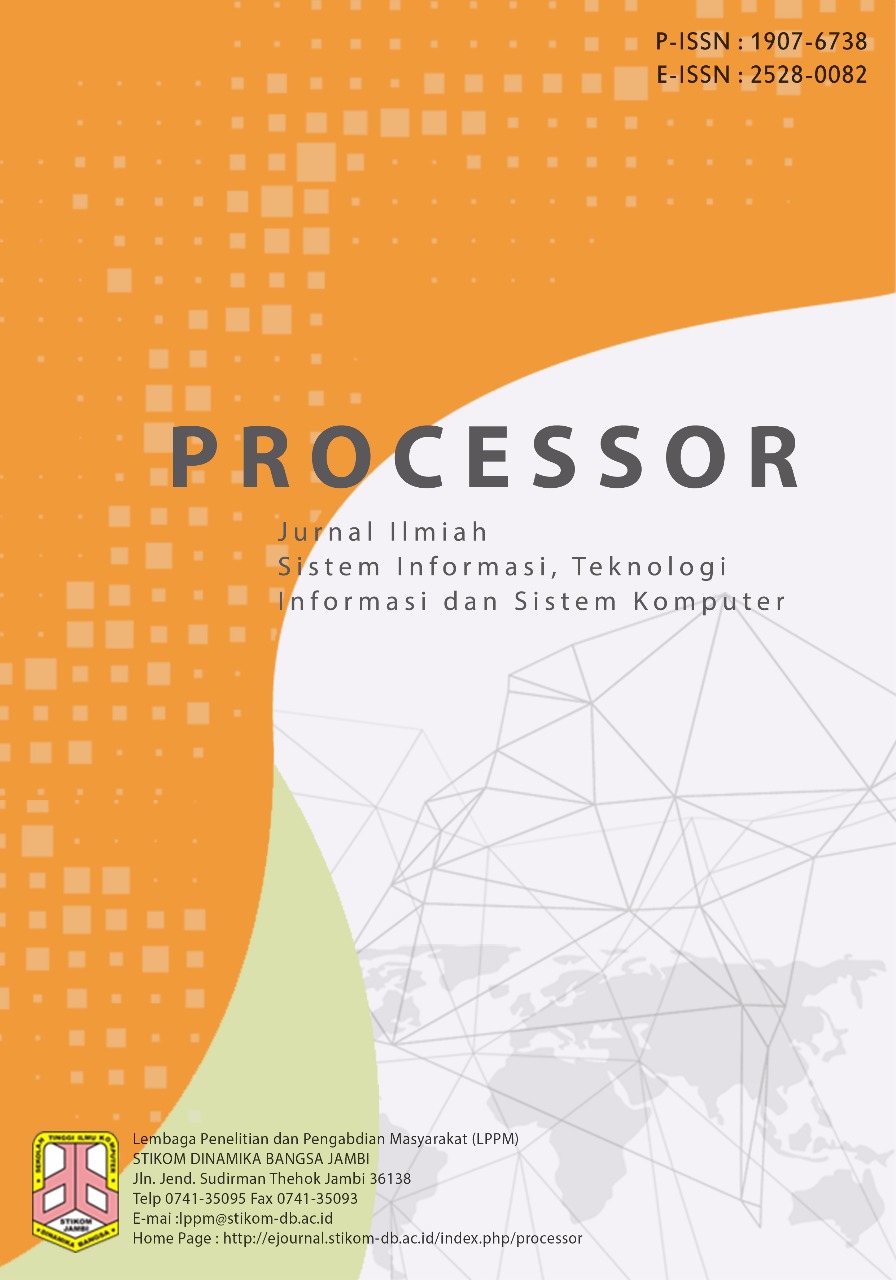Pengaruh Perceived Usefulness dan Perceived Ease of Use terhadap Continuance Intention to Use Mobile Banking dengan Trust sebagai Variabel Intervening (Studi pada Pengguna Aplikasi Bank Jambi Mobile di Kota Jambi)
DOI:
https://doi.org/10.33998/jumanage.2022.1.2.86Abstrak
This research aims to determine the direct or indirect effect of perceived usefulness and perceived ease of use on continuance intention to use of the Bank Jambi Mobile application, with trust as the intervening variable. The research sample used was 96 respondents, where data from the sample was collected using a questionnaire and then analyzed using the partial least squares path modeling (PLS) technique. The results of the direct influence test prove that perceived usefulness has no significant effect on trust, while perceived ease of use has a significant effect on trust. Meanwhile, trust has a significant effect on continuance intention to use. For the mediating effect of the trust variable, it is proven that trust can mediate the indirect effect between perceived ease of use on continuance intention to use. However, it cannot mediate the indirect effect of perceived usefulness on continuance intention to use. The results of the study have implications for the efforts of the management of Bank Jambi as an application provider to increase the benefits and ease of use of the Bank Jambi Mobile application, as well as public trust in the application.
Unduhan
Referensi
Ashghar, S. A., & Nurlatifah, H. (2020). Analisis Pengaruh Perceived Ease of Use , Perceived Usefulness , dan Perceived Risk terhadap Keinginan Membeli Kembali melalui e-Trust dan s-Satisfaction. Jurnal Al Azhar Indonesia Seri Ilmu Sosial, 1(1), 40–52
Aydin, G., and S. Burnaz. (2016). Adoption of Mobile Payment Systems: A Study on Mobile Wallets. Jounal of Business, Economics and Finance, 5 (1)
Chaidir, T., Ro’is, I., dan Jufri, A. (2021). Penggunaan Aplikasi Mobile Banking pada Bank Konvensional dan Bank Syariah di Nusa Tenggara Barat: Pembuktian Model Unified Theory of Acceptance and Use of Technology (UTAUT). Elastisitas: Jurnal Ekonomi Pembangunan, 3 (1), 61-77
Chang, Y. P., & Zhu, D. H. (2012). The Role of Perceivedd Social Capital and Flow Experience In Building Users’ Continuance Intention To Social Networking Sites In China. Computers in Human Behavior, 28 (3), 995–1001
Chin, W. C., & Todd, P. A. (1995). On the Use, Usefulness and Ease of Use of Structural Equation Modelling in MIS Research: A Note of Caution. MIS Quarterly, 19 (2), 237-246
Chinomona, R. (2013). The influence of perceived ease of use and perceived usefulness on trust and intention to use mobile social software. African Journal for Physical, Health Education, Recreation and Dance (AJPHERD), 19 (2), 258-273
Davis, F. D., R.P. Bagozzi, and P.R. Marshaw. (1989). User Acceptance of Computer Technology: A Comparison. Management Science, 35 (8), 982-1003
Faradila, Rr. Selli Nisrina dan Soesanto, H. (2016). Analisis Pengaruh Persepsi Kemudahan Penggunaan dan Persepsi Manfaat terhadap Minat Beli dengan Kepercayaan Sebagai Variabel Intervening (Studi pada Pengunjung Toko Online berrybenka.com di Kalangan Mahasiswa Universitas Diponegoro). Jurnal Studi Manajemen & Organisasi, 13, 149-160
Garbarino, E. and Johnson, M.S. (1999) The different roles of satisfaction, trust and commitment in consumer relationship.Journal of Merketing, 63 (2), 70-78
Gupta, A., & Arora, N. (2017). Understanding Determinants and Barriers of Mobile Shopping Adoption Using Behavioral Reasoning Theory. Journal of Retailing and Consumer Services, 36, 1–7
Hartono, J. (2007). Sistem Informasi Keperilakuan. Andi Offset. Yogyakarta
Kurniawati, H.A., Winarno, W.A., dan Arif, A. (2017). Analisis Minat Penggunaan Mobile Banking Dengan Pendekatan Technology Acceptance Model (TAM) Yang Telah Dimodifikasi (Analysis Behavioral Intention to Uses of Mobile Banking Technology Acceptance Model (TAM) Approach Modified). e-Journal Ekonomi Bisnis dan Akuntansi, 4 (1), 24-29
Larassita, N., Razati, G., Sulastri, S. (2019). Apakah Perceivedd Usefulness Dapat Meningkatkan Continuance Intention?. Journal of Business Management Education, 4 (1), 13-24
Mahendra, Y. A. S., W. W. Winarno, and P.I. Santosa. (2017). Pengaruh Perceived Security terhadap Pengadopsian In-App Purchase pada Aplikasi Mobile. Jurnal Nasional Teknik Elektro Dan Teknologi Informasi (JNTETI), 6 (2), 184–193
Mayer, R.C., Davis, J.H., Schoorman, F.D. (1995). An Integrative Model of Organizational Trust. The Academy of Management Review, 20 (3), 709-734
Nasution, R.A. dan Widjajanto, A.S. (2007). Proses Pembentukan Kepercayaan Konsumen: Studi Kasus pada Sebuah Usaha Kecil Menengah Percetakan Digital di Bandung. Jurnal Manajemen Teknologi, 6 (2), 95-114
Pan, M.-C., Kuo, C.-Y., Pan, C.-T., & Tu, W. (2013). Antecedent of purchase intention: online seller reputation, product category and surcharge. Internet Research, 23(4), 507–522
Pemayun, Cok Istri Shintia Dewi Haruna.,Suasana,I Gst Agung Ketut Gede. (2015). Peran Kepercayaan dalam Memediasi Hubungan antara Persepsi Nilai dan Keputusan Pembelian Produk Hijau Herbalife di Kota Denpasar. E- Jurnal Manajemen Unud, 4 (12), 4186-4218
Pramesthi, F. (2013). Efek Perceived Ease of Use dan Confirmation terhadap Anteseden Online Repurchase Intention. Fokus Manajerial, 12 (1), 81-91
Prathama, F. dan Sahetapy, W.L. (2019). Pengaruh Kemudahan Penggunaan Aplikasi dan Kepercayaan Konsumen terhadap Minat Beli Ulang Konsumen E-Commerce Lazada. Agora, 7 (1)
Purwanto, E. (2020). Technology Adoption: A Conceptual Framework. Yayasan Pendidikan Philadelphia.Tangerang
Rahab dan Sutianto, F.D. (2011). Information Technology Continuance Model dan Kepercayaan dalam Kontek Keberlangsungan Pemanfaatan Layanan SMS Banking. Journal & Proceding Feb Unsped, 1 (1)
Rizanata, Muhamad Fahmi. (2014). Pengaruh Kepercayaan Pelanggan terhadap Word Of Mouth, Niat Beli dan Retensi Pelanggan Gerai Indomaret di Surabaya. Journal of Business and Banking, 4 (1), 31-42
Shaikh, A.A. (2013). Mobile Banking Adoption Issues in Pakistan and Challenges Ahead. J. Inst. Bankers Pak, 80 (3), 12–15
Subagio, Dyajeng Puteri Woro, Mugiono, dan Djumillah Hadiwidjojo. (2018). Pengaruh Perceived Ease Of Use Terhadap Repurchase Usefulness Dan Trust Sebagai Variabel Mediasi. Jurnal Manajemen & Kewirausahaan, 6 (1), 35-44
Susanto, A., Chang, Y., & Ha, Y. (2016). Determinants of Continuance Intention to Use the Smartphone Banking Services. Industrial Management & Data Systems, 116(3), 508–525
Thong, J. Y. L., Hong, S. J., & Tam, K. Y. (2006). The Effects of Post-Adoption Beliefs on the Expectation-Confirmation Model for Information Technology Continuance. International Journal of Human Computer Studies, 64(9), 799– 810
Veijalainen, J., Terziyan, V., &Tirri, H. (2006). Transaction Management for M-Commerce at A Mobile Terminal. Electron. Commer. Res. Appl, 5 (3), 229– 245
Venkatesh, V., and F. Davis. (2000). A Theoritical Extension of the Technology Acceptance Model: Four Longitudinal Field Studies. Management Science, 45 (2), 186-204
Widiartini, P.R. dan Ni Nyoman Kerti Yasa. (2017). Peran Kepercayaan dalam Memediasi Hubungan Persepsi Nilai dengan Niat Menggunakan E-Money. Matrik: Jurnal Manajemen, Strategi Bisnis dan Kewirausahaan, 11 (1), 11-25
Wilson, N. 2019. The Impact of Perceived Usefulness and Perceived Ease-of-Use toward Repurchase Intention in the Indonesian E-Commerce Industry. Jurnal Manajemen Indonesia, 19 (3), 241- 249
Yudaruddin, R. (2020). Mobile Banking, Kinerja dan Stabilitas Keuangan: Studi Empiris di Perbankan Indonesia. Buletin Riset Kebijakan Perbankan, 2 (1), 2-29
Zhang. (2017). How Wechat Can Retain Users: Roles Of Network Exterbalities, Social Interaction Ties, Adn Perceived Values In Building Continuance Intention. Computers in Human Behavior, 69, 284-293















